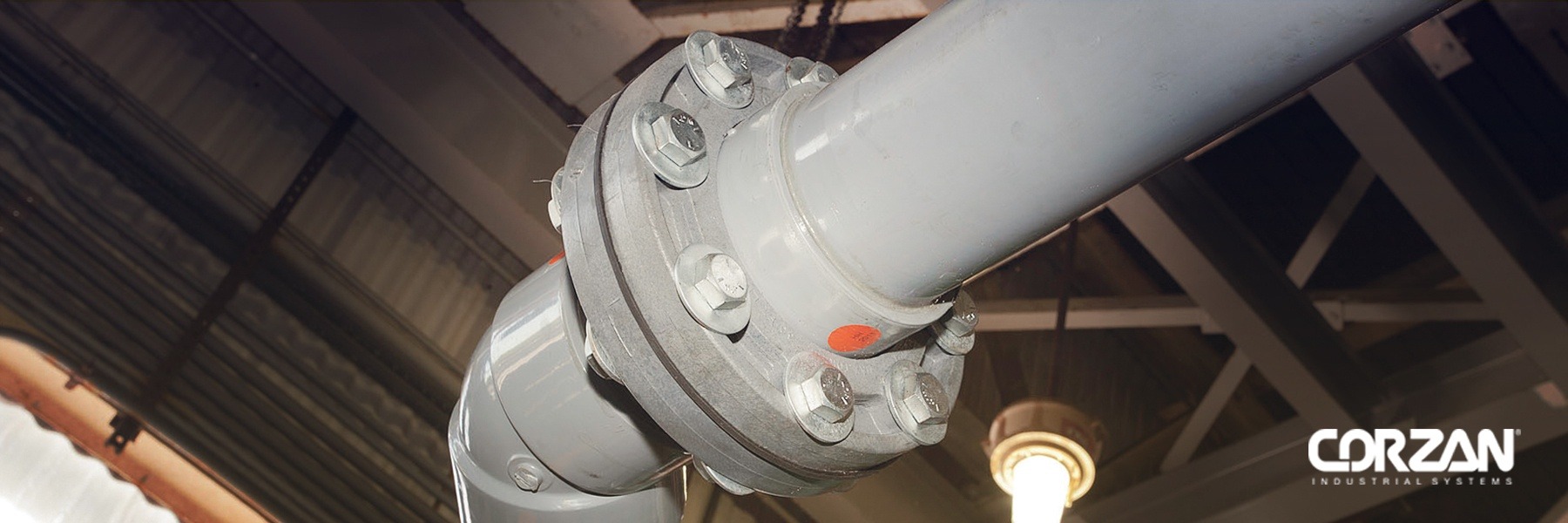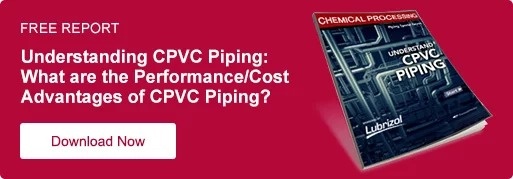The 3 Key Factors in CPVC Welding Rod Reliability
As the saying goes, “a chain is only as strong as its weakest link.” With an industrial system, the same rule applies. Though welding rod material accounts for a seemingly insignificant fraction of a system, if it fails—whether from corrosion, pressure or temperature demands—the whole system is affected.
Due to chlorinated polyvinyl chloride’s (CPVC) inherent chemical resistance and overall performance, CPVC sheet is often fabricated for different industrial uses.
Whether the CPVC sheet is fabricated to be the tank lining in an air scrubber, for a storage tank built entirely out of CPVC sheet, or for a specialty fitting, the welded seams must maintain the strength and reliability of the CPVC material.
In each case, correct welding rod selection and effective welding techniques directly correlate to how long the system will last before requiring repair.
Understanding CPVC and Hot Air Welding
In CPVC formulation, the large chlorine atoms—along with protective additives used to enhance the resin—give CPVC increased temperature performance and fire resistance, among other important attributes.
With hot air welding, CPVC’s increased chlorine content makes welding rod specification and welding technique especially important because the stiffer molecules require more heat and time to weld.
During hot air welding, both the welding rod and adjacent pieces of sheet are heated until they reach a melting state. This allows the material to soften and the molecules to move more freely.
As heating occurs, the pieces are pushed together for a certain amount of time at a specific pressure, allowing the surface molecules of each piece to entangle and bond together. The better the entanglement, the better the corrosion resistance and physical strength of the seam.
How To Increase Welding Rod Reliability
To lessen the likelihood that a fabricated seam will require early repair, the welding rod and sheet material should come from the same manufacturer, and be fabricated by a skilled, experienced welder.
1. Choose a Welding Rod With Equivalent Formulation to the Sheet
The molecular makeup of the welding rod must match that of the sheet being fabricated. If the welding rod does not maintain equivalent performance to the sheet in a certain area—such as corrosion or pressure resistance—it is likely to be the point of failure.
The variance in performance between two brands of CPVC material can be surprisingly significant.
Specifically, five primary performance tests should be considered for welding rod and sheet selection. Note that Corzan® CPVC is used as an example show how the performance of two materials with the same name can be vastly different.
- An Izod Impact Rating is the ASTM standard for determining the impact resistance of a material. Corzan CPVC, for example, tests up to 10.6 ft. lbs/in.2 (22276.13 J/m2), which is approximately 10 times greater than some test results of generic CPVC.
- The Heat Distortion (or Deflection) Temperature (HDT) is the highest temperature the material can withstand before deforming. Corzan CPVC is rated up to 200°F (93.3°C), while other brands have tested below 185°F (85°C).
- The Tensile Strength of a material refers to how much force it can withstand and still return to its original shape. Corzan CPVC’s is 7,410 psi, while alternatives have tested below 6,500 psi.
- The Tensile Modulus defines stiffness, where lower values may indicate lower molecular weight or fusion quality issues. Corzan CPVC’s is 388,000 psi, with alternatives testing near 350,000 psi.
- The Vicat Softening Point is the temperature at which a material that has no definite melting point start to soften or allow a narrow specimen to penetrate the exterior. Corzan CPVC’s Vicat softening temperature is 212°F (100°C) and other CPVC has tested near 194°F (90°C).
In these examples, if a fabricator used Corzan CPVC sheet and generic CPVC welding rods, the welding rods would likely fail under the harsh conditions of a processing application first.
2. Match the Welding Rod and Sheet Manufacturer
In addition to using a material with the same inherent molecular properties for both the sheet and welding rod, ensure it comes from the same manufacturer. Most sheet manufacturers also produce welding rods.
These manufacturers are able to achieve maximum chemical resistance from the finished material. Their processes ensure that the CPVC molecules have:
- Melted and become completely disentangled.
- Tangled back together with equal dispersion of the performance enhancing additives.
- Ultimately entangled together as tightly as possible to minimize free volume.
If molecules do not completely entangle or minimize free volume in the finished sheet or welding rod, weaknesses in the material will accelerate the rate of degradation.
If the manufacturing process is maximized, not only will the material be more consistent and reliable in general, but it will also make effective entanglement between the welding rod and sheet more easily achievable during hot air welding.
Also, make the distinction between the distributor and manufacturer. Doing so is the safest way to ensure the welding rod maintains equivalent performance as the sheet.
3. Welding and Fabrication Effectiveness
The final step to achieve reliable seams is to use a fabricator or welder with the skill and experience to consistently achieve proper welds.
When properly welded, the fabricated system is expected to perform to approximately 80% of its nominal tensile strength—a weld efficiency factor of 80%.
Less qualified or detailed welders may create a cold weld. This is when the weld looks complete, but the molecules have not completely entangled. Depending on the system’s chemicals and conditions, the seam can fail.
Consistent hot air welds that uphold the weld efficiency factor of 80% depend on correct equipment and material selection, proper weld preparation and correct structural welding.
Standards for thermoplastic welding were developed for the United States by the American Welding Society (AWS) and approved by the American National Standards Institute (ANSI), and for Europe by the DVS (German Welding Society). Each instance explains the requirements of welding specification and the operations to be followed.
Learn More About CPVC Fabrication and Welding
Corzan Industrial Systems partners with manufacturers who have a proven track record of quality and reliability. Each of which is contractually required to participate in our Quality Assurance Program.
Contact us to connect with our team of product and engineering specialists, who is happy to pair you with welders in your area and advise you on the most effective approach to system fabrication.


